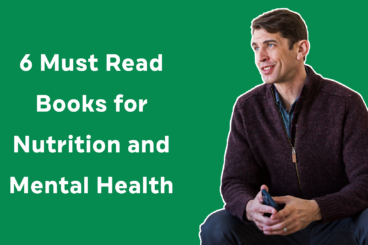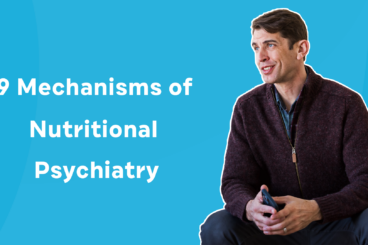I wanted to talk to you about some of my favorite, easy, accessible foods that I’m always prescribing or talking with patients about. I’m a nutritional psychiatrist, so when I work with patients on their mental health, I also look to tweak what’s called their dietary pattern. I try to understand how someone eats and without too much disruption, I want to try and improve their dietary pattern. There are a few foods I find myself going back to over and over again because they’re easy, accessible and delicious. I find they’re also great utility foods when it comes to improving nutrient density and the diversity of nutrients that my patients are getting, especially the nutrients that many with depression and anxiety are missing. This is for example, nutrients like fiber, magnesium or zinc.
Olive Oil
The first food I keep going back to is olive oil. If you think about how to shift the fatty acid intake of an individual, getting a big jug of olive oil and making that the primary fat that you’re eating is a great goal and an easy way to shift someone’s dietary pattern to a more Mediterranean feel. When you look at the data from the AMMEND trial, which is the most recent randomized clinical trial in nutritional psychiatry, one of the big changes that Jessica Bayes reported was getting more olive oil into those young men’s diets. We’ve got a great interview with Jessica if you want to hear more details about that.
Lentils
Next up would be lentils. Lentils are an easy legume which have a lot of fiber and folate. They’re easier to prepare than beans. I use them in salads. I put them in omelets. Lentils are a great food to add in if it hasn’t been a part of your dietary pattern.
Pesto
Number three on the list is pesto and pesto is important for a few reasons. One is it’s a nice way to get more greens in your diet because you blend up foods like basil or kale so you get a lot of concentrated greens in there. It’s also this kind of perfect mix which includes olive oil, garlic, nuts and greens, usually herbs. Also, basil has a lot of this compound called linalool, which is a very interesting anti-inflammatory.
Salmon
I’m always looking for seafood. If people have seafood as part of their dietary pattern, that’s great and I’m going to want to trend that towards the fatty fish with of long-chain omega-3 fatty acids. So number four, because it’s available everywhere, is wild salmon. This is your high omega-3 fish. I’ll recommend people put some pesto on top of that if they’re new to fish. Salmon is the most accessible to most people. There’s a great wild salmon burger in my most recent book Eat to Beat Depression and Anxiety that uses canned wild salmon, which is a great way to save money. Don’t have to worry about freshness. It’s high quality salmon. So check that out if you’re trying to add some salmon recipes to your repertoire.
Potatoes
All right, this next food might surprise you. These are potatoes and there’s a variety of potatoes that I love. One of the reasons I use this as an early food is because people often are having a lot of carb cravings when they have depression and anxiety. There’s a lot of anxious snacking and emotional eating that happens when people struggle with their mental health. So people just go into eating no carbohydrates or low carbohydrates but potatoes and other starches are really helpful. They still have fiber, they have phytonutrients, some potatoes have a lot of iodine and vitamin C and there’s just a lot of variety. I like blue potatoes and purple sweet potatoes. Overall, when it comes to fruits such as potatoes, tomatoes, blueberries, smaller is a nice rule of thumb. So if you get a nice, small, wild blueberry, you’re getting more skin and less sugar. The same idea goes for potatoes, because the skin is where a lot of the vitamins and minerals in phytonutrients live.
Kefir
Next up is kefir but a lot of people don’t know what kefir is. I didn’t until I got into this work. Kefir is a liquidy fermented dairy product. The reason I like kefir is because it has so many colony forming units (CFUs). CFUs are what is advertised on a probiotic package. You get a lot more in kefir and it’s great for smoothies because it’s a little liquidy. I’m not a huge fan of yogurt smoothies, to be honest. If yogurt is your fermented food of choice, that’s a great one too. Having a go-to daily, fermented food in your diet is really important. It’s a nice shift that people can make in terms of increasing the diversity of their microbiome. This is a central part of nutritional psychiatry about how to get your system nourished in a way that best supports your mental health.
Wild Blueberries
Last up, because it’s easy, it’s delicious and it goes in so many things would be wild blueberries. I like them when they are frozen so you get a fresh, less expensive product and also wild blueberries are smaller in size. That means you get more skin, more of those anthocyanins, which is the blue pigment molecule that influences the microbiome and inflammation. That is how it influences mental health. I put wild blueberries usually in a smoothie with some of that kefir or a little bit of vanilla, maybe a banana and I’m always putting nuts in my smoothies because I want some protein and some fat in there. I don’t want a big sugar bomb of blueberries in the morning. Another way I suggest people use them is if they are trying to get off of more sugary products, having some wild blueberries over some plain yogurt in the evening is good. If you add a little drizzle of maple syrup you can control the amount of sweetness going in which is a nice move.
Those are some of the foods I prescribe most often for depression.They add a lot of nutrient density, they help people and I hope they inspire you to get a few of those into your dietary pattern this week.



